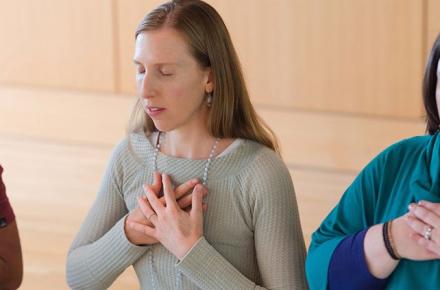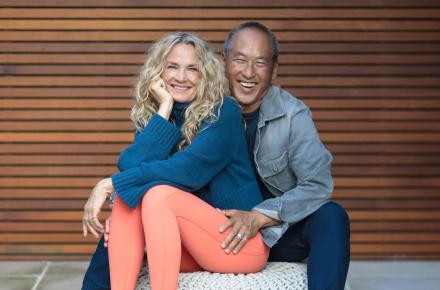Coming Home to My Body, in Sickness and in Health

by Julie Bolitho
In 2004, at the age of 19, I was diagnosed with metastatic thyroid cancer. It was one of the best things to ever happen to me.
Despite already having an autoimmune disease of the thyroid as a young teenager, having cancer, a disease that carries heavy cultural connotations, woke me up to the disconnect that existed between my mind, body, and spirit in a way that the autoimmune disease could not. Fourteen years later, I am still learning lessons about caring for my body and taking responsibility for my wellness. As with any education, the lessons have not always come easily.
We live in an era of vast communication. One could take cues on wellness from any tradition in the world, whether Eastern or Western, and most will conflict. One professional will tell you to eat nuts in abundance, while another will tell you to avoid them. One physician will tell you to radically change your lifestyle, while another will insist that the only way to wellness is to remove an offending organ. With so much information, one must be not only discerning, but also brave—to research thoroughly, follow instincts not previously cultivated, and, most importantly, have a sense of agency about one’s own health.
It was having cancer that first led me to yoga, and eventually led me down a personal journey of vegetarianism and then veganism. While I have been vegan for the better part of a decade now, and while I firmly believe in better, more humane, more environmentally friendly farming practices, I also understand that my journey is solely my own.
It was a journey that met with many cultural and medical obstacles. Family, friends, and my GP worried about my health, as they knew so little at the time about a diet so radically different from the norm. Going from a standard American diet to one of whole foods took years. My taste buds and digestive system took time to adapt, to appreciate new flavors and textures, and to relinquish previously enjoyed tastes. What has allowed me to be open to changes in my diet has been the acceptance of change in general. Each day passes. Our bodies age. Our needs shift.
I recently heard the question, “Would you rather be truthful or would you rather be consistent?” It is an excellent question to ask of our bodies: Would you rather honor your body in a given moment or would you rather be consistent or dogmatic in your diet and practices? I once had a client arrive at a yoga class incredibly unwell. She had a desire to lose weight and yoga was one practice she used to stay physically active. This desire for weight loss implanted in her such a rigid ideology that the idea of nourishing her body with rest instead of attending a yoga class was unthinkable.
At one time, I would have been like my client. Cancer instilled in me a desire to control everything. I often chose not to take public transport out of fear. I became completely inflexible in my relationship to food. I punished my body with gruelling training that caused more injuries than benefits. I went through periods of following strict diets, from complete raw foodism to a ketogenic approach (which is nearly impossible as a vegan). It took years, my yoga teacher training at Kripalu, and even some therapy to move beyond my insatiable desire to control my body and my destiny.
I no longer desire to have a perfect body (most of the time), but what I desire is to have a nurtured body—one that is radically loved through every movement and every mouthful. It’s not always easy, and I’m often unsuccessful, but the intention is there. And intention is where we start.
For anyone suffering with illness, disease, or body image issues, the only advice I can give (among the millions of pieces of advice on the internet) is to start with intention. One of the greatest lessons I learned at Kripalu is that whatever we practice, we get better at. So, if you practice telling yourself how awful your body is, how dangerous your body is, how wrong you are, you’ll get better at believing those things and living from that dark space. Likewise, if you practice telling yourself how beautiful your body is, how strong your body is, how strong and beautiful you are, you will get better at believing those things (no matter how impossible it may seem initially) and living from those truths.
With intention, the journey begins, but, as in most journeys, it is rarely straightforward—Point A rarely meets Point B quickly or easily. Recently, at the Tate Modern in London, a museum of modern art, one of my undergraduate literature students resonated with a series of chalkboards full of lines, drawings, and erasure marks—a work of modern art that would feel completely nonsensical to many viewers. She noted that the chalkboards reminded her of the trajectory of her own life, or of any life—full of twists, turns, backtracks, diversions, and new paths.
Here is what I know: Illness can be one of our greatest launching pads into wellness and self-discovery, if we allow it to be. It can also be devastating if we feel no sense of agency in how we live in our bodies in whatever time we have left in them. Being mindful and being an advocate for your health and your values offer a sense of empowerment. Yet, being open to changes in your planned course remains equally important. And ultimately, setting the intention to love yourself and your body provides the catalyst for meaningful change.
I offer the following affirmation anytime you experience frustration with your body: I have a beautiful body. I nourish my body with every breath, with every movement and with every mouthful. My body is intricate and it is miraculous. I am grateful for my body’s ability to heal. I am grateful for every opportunity to love my body and take care of myself. In caring for myself, I give my best to the world.
And here’s a something else that has proven extraordinary in my own life, a powerful addition to any wellness regime.
Julie’s Flu-Fighting, Immune-Loving Turmeric Tonic
You’ll need a cold-press juicer to make this tonic.
4 small pieces of raw turmeric root
2 large ginger roots (the whole root)
1 apple
1 lemon
2 teaspoons of raw, cold-pressed coconut oil or raw, omega-oil blend (like Udo’s Choice)
½ teaspoon of cinnamon
¼ teaspoon of black pepper
Cold-press the turmeric, ginger and apple. Juice the lemon without the rind.
Mix together the turmeric, ginger, apple, and lemon juices with the cold-pressed oil. (Some studies suggest that the curcumin in turmeric—the cancer-fighting compound—is more easily absorbed when taken with fat.)
Mix in the cinnamon and black pepper. Sometimes it helps to do this all on low speed in a blender, though it can also be done by hand. (Some studies suggest that black pepper and cinnamon, like the oil, help the body to better absorb the healing properties of the turmeric.)
Finally, be kind to yourself and your body. Remember that there are only two homes: the body and the earth. Both are worthy of your love and devotion.
Julie Bolitho is a Kripalu Yoga teacher from northern Michigan who currently resides in Oxfordshire, England. A Truman Scholar and a published poet and essayist, Julie is currently at work on a memoir. juliebolitho.com, sanctuarygrace.com
© Kripalu Center for Yoga & Health. All rights reserved. To request permission to reprint, please email editor@kripalu.org.

















































